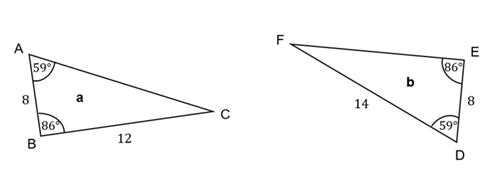The MAP Growth Test for 9th-12th grade students is an assessment designed to measure academic ability on a scale that compares them to students both within and outside their age group. Thus, it has become a great tool for spotting exceptional academic talents and abilities. High MAP scores could lead to many open doors in the future.
The MAP is an adaptive K-12 assessment aligned with Common Core standards, focusing on math, reading, language usage, and science. Each test features 40-43 questions without time limits, adjusting in difficulty based on responses to accurately measure students' knowledge levels.
Beyond tracking academic progress, the MAP Growth is also used as an entrance exam by some programs.
Check out our general Free MAP Practice or access PrepPacks by grade:
Free 9th, 10th, 11th, and 12th Grade MAP Sample Questions
The following are sample questions for the math, reading, and language usage tests, taken from our MAP 9-12 PrepPack. We have divided the questions across the various subjects and approximate grade levels, though a high schooler of any age could receive questions resembling any of these examples on the test.
Math
Help Your Child Prepare for Their MAP Test
Explore our MAP Practice PrepPacks that include
Realistic Simulations
PrepPacks tailored to accurate test scenarios.
Interactive Tests
Practice materials, designed to help students perform their best on their tests!
Premium Quality
Expert-crafted practice tests with accurate questions and explanations
Reading
Prepare Your Child for the MAP 3rd Grade Test!
Practice with the most complete studying materials including 250 sample questions, MAP math quizzes, MAP reading quizzes, two full-length MAP simulation, a comprehensive study guide, and a detailed score report to track your child's progress.
Language Usage
Pave Your Child's Way to Success!
469 Questions & Explanations
From $89
The following are outlines of each of the popular MAP Growth tests, math, reading, and language usage, detailing the subjects they cover and the knowledge and skills they aim to test:
MAP Math for 9th-12th Grade
- Algebraic Concepts: Solving for numeric value of letters in functions, expressions, equations, inequalities, mixed operations, and more.
- Computation and Operations: Individual and mixed operations with fractions, decimals, multi-digit whole numbers, negative numbers, exponents, and more.
- Data and Probability: Understanding data from graphs, charts, etc. and how to analyze it and draw conclusions from it, as well as determining probability.
- Geometry: Properties of and calculations for lines, angles, and shapes, three dimensional figures, coordinates and transformations, and applying basic trigonometry.
- Measurement: length, perimeter and circumference, area, capacity, volume, weight and mass, temperature, time, money, and unit conversion.
- Number Sense: Place value, estimation and rounding, proportions and ratios, equivalency.
MAP Reading for 9th-12th Grade
- Informational Texts: Understanding the content and main ideas in informational texts, locating information and drawing conclusions from it; analyzing elements such as persuasion, bias, cause and effect, fact and opinion, sequence, directions, and more.
Identifying and analyzing the purpose and structure of informational texts; includes interpreting the mood, tone, point of view, argument, and others, as well as classifying the text. - Literature: Reading and understanding literary texts, identifying details and main ideas, locating information and drawing conclusions from it, analyzing elements such as setting, plot, characters, and moral.
Identifying and classifying the purpose and structure of literary texts; includes identifying and analyzing the use and effect of various literary devices, such as figurative language, descriptive language, plot devices, poetic elements, dramatic elements, and rhetorical techniques. - Word Meaning: Classifying and identifying word and phrase meanings and uses based on vocabulary knowledge, roots and affixes, context, presented sources, and more.
MAP Language Usage for 9th-12th Grade
- Mechanics: The technical aspects of the English language; includes the proper use of capital letters—such as in proper nouns and titles, punctuation—such as commas, semicolons, apostrophes, and others, and spelling.
- Parts of Speech: Knowing how to recognize, use, and differentiate between each of the different types of words, such as nouns, verbs, adjectives, and others; includes identifying and understanding different categories within the parts of speech, such as personal pronouns or conjunctive adverbs, as well as the different tenses of verbs and their agreement with nouns, and more.
- Usage: The rules and terms of sentence structure, or syntax—in other words, how to properly form sentences and break them down to their functional parts; includes classifying and differentiating between different types of sentences and sentence parts, as well as recognizing their proper usage.
- Writing Process: Knowing how to properly build bodies of writing; includes identifying and analyzing different genres, structures, rhetorical techniques, literary elements, and more.
MAP Scores
Each question on the MAP test is designed to assess certain academic abilities measured over ranges of levels in a system called RIT, which stands for Rasch Unit. By answering a given question correctly, a student demonstrates that he or she has the ability tested in the question, and thereby suggests a readiness for questions of a similar level according to their RIT range. After the test presents the student with enough of these types of questions, it will be able to calculate which average level of RIT they will have a 50% chance of answering correctly, and that number will be their score.
All students receive a general score as well as one for each topic, and they also receive these scores in percentile form. The main percentile scores reflect the students’ performance in relation to others in the same grade and time of year, and an additional one compares them to others who scored similarly to them on the last test they took, thus keeping track of both their overall standing as well as their level of improvement.
Visit TestPrep-Online’s MAP scores page to find more information on MAP high school level Testing scores.
MAP Preparation
You can only gain from preparing for the MAP test. If you or your child is taking the test as an entrance exam, you should certainly prepare, as this will significantly increase your chances of being accepted to your school of choice. When taking the test regularly in school, or even for placement within a program, you can still only benefit from preparing, as it will give you the proper tools to more accurately represent just how smart you are. This is, in part, because you will be less likely to stumble over careless mistakes, and your incorrect answers will more likely reflect the things you genuinely don’t know as opposed to a lack of understanding of the test and its style of questioning. Additionally, properly preparing for the MAP can actually help you progress in your academic growth such that your higher scores would reflect your newly advanced level. Proper MAP prep can improve your understanding of materials you learned in school and help you acquire new knowledge and skills that will accelerate your education, ultimately affording you greater academic opportunities in your future.
Preparing with TestPrep-Online
Coming soon: A complete preparation package that will include quizzes for the math and reading tests categorized by approximate grade level (9, 10, 11, 12), full-length simulations for the math, reading, and language usage tests, answers and detailed explanations for each of the questions, and study guides with introductory quizzes for the math section. We will also offer a version of the pack that will include video lessons teaching the material tested in the language usage test.
Tips for Acing the MAP Growth for High School Levels
- Plan out deadlines and priorities. Make a study plan and prioritize topics according to your strengths and weaknesses. Our PrepPack will have section-specific quizzes and practice tests, so you can easily focus on one skill at a time, if necessary.
- Practice questions over and over again. This will help you get used to this type of test taking while at the same time familiarizing yourself with the knowledge and skills needed to answer questions on the MAP. Our PrepPack will include 266 original questions and explanations for each answer, giving you plenty to practice.
- Read the explanations. Even if you got the question right, you can learn a lot from the explanations. They provide a foundational understanding of the topic that may help you with similar questions you might have otherwise missed, and they can show you easier ways of reaching the correct answer.
- Take your time. The test is untimed, so no need to rush. Make sure you truly understood the question and didn’t overlook anything.




